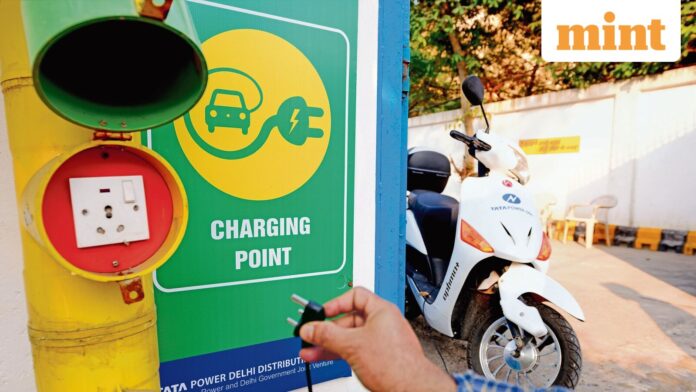During their latest quarterly earnings calls, both Ola and Ather highlighted their improving unit economics, with gross margins close to the levels of the ICE manufacturers. However, the operating margin picture still differs sharply.
On gross margins, Ola Electric closed the July–September quarter with 30.7% gross margins, an expansion of more than 11 percentage points from a year earlier. Ather Energy’s gross margins also rose—up three percentage points to 22%. These figures are now comparable to the 29–34% gross margins typically reported by Hero, TVS, and Bajaj.
But on operating margins, Ather posted a –10% Ebitda margin in July-September, and Ola Electric reported its first positive operating margin of 0.3% in the same quarter, compared to the 14–18% margins of the legacy companies. Ola said it expects 5% Ebitda margin and 40% gross margins in January–March.
Gross margin captures product-level profitability, while Ebitda margin reflects the organisation’s profitability after operating costs but before depreciation, interest and taxes.
The differing trajectories reflect structural advantages for new-age players, according to experts.
“New-age companies are working with ground-up EV platforms rather than adapting petrol architectures—this removes multi-powertrain overheads and yields a structurally leaner cost base,” explained Harshvardhan Sharma, group head at Nomura Research Institute.
“While legacy players typically carry fixed ICE-related costs across tooling, compliance and multi-SKU supply chains, EVs still form only a small share of their overall volumes, often in the low single digits, which inevitably delays margin expansion,” he said.
Sharma added that new-age EV makers benefit from tightly focused product platforms, which allow faster scale gains on batteries, frames, software, and power electronics—alongside growing software-led monetisation.
“Taken together, these factors explain why some early EV-focused OEMs are showing faster Ebitda recovery, while legacy players are likely to see a more gradual trajectory as their EV volumes scale and their cost stacks realign,” he said.
Numbers play
The legacy players are not upfront about the profitability and margins of their electric portfolio, unlike the new-age companies.
While Bajaj Auto told investors that three of four of its electric two-wheeler models are close to achieving breakeven, TVS and Hero MotoCorp told investors they are moving closer to profitability, but did not reveal the exact numbers.
Ather Energy chief executive Tarun Mehta told investors during an analyst call on 11 November that the Ather’s numbers are “clean” without mixing with incentives or cost structures of other businesses.
“I think the EV business should be able to command as much or even a little better gross margin than the ICE portfolios could, because of the ability to upsell a lot of things with EVs, particularly around the software and the accessory front,” Mehta said during the call.
Earlier, on 6 November, Ola Electric founder Bhavish Aggarwal said during the firm’s earnings call that competitors were “buying market share” without considering unit economics and profitability.
“We don’t mind a little bit of market share loss to other guys who are actually buying market share and it’s not that their structural business model delivers them higher market share,” he told investors and analysts. “Whereas our business model now, our product leadership is all structural. The gross margin reflects that and our operating margin also now reflects that.”
Traditional companies, meanwhile, said they are happy with the progress of their electric portfolio, but did not reveal any numbers.
“In principle, a new category you look at overall, are we gaining total volume because we have to invest somewhere and the results will come maybe a couple of years later, two years later, three years later,” K.N. Radhakrishnan, director and chief executive at TVS Motor Company, said during an analyst call on 28 October. “So, EV is going through that journey, but we are extremely happy on the EV journey so far because both two-wheelers and three-wheelers are doing well.”
Bajaj Auto told investors that the rising share of three wheelers in its EV sales helped in raising the profitability of its electric business. According to Rakesh Sharma, executive director at Bajaj Auto, the electric operating profit margin was in double digits led by three wheelers.
“It (EV positive margins) is coming out of a mix of a growing proportion of the electric three-wheelers plus better unit economics on the Chetak models,” Dinesh Thapar, chief financial officer at Bajaj Auto, said in the company’s earnings call on 8 November. “If I just look back in time, same time last year, on the three of our lead models on Chetak, we would have been bleeding Ebitda. As I look at the current moment, we are nearly Ebitda neutral on all of them.”
Chetak is Bajaj Auto’s electric scooter brand.
Meanwhile, Hero Motocorp, the country’s largest two-wheeler manufacturer, stated in its earnings call that the company wants to focus on building the electric brand right now.
“We will continue to leverage benefits like the PLI (production-linked incentive), in order to bring the EV business overall into a more positive roadmap,” Kausalya Nandakumar, chief business officer of the company’s emerging mobility business unit, said during an earnings call on 14 November.
“Having said that, the current focus for Vida and Hero MotoCorp continues to be focused on bringing new products into the market as well as building the brand so that we can drive customer adoption in the EV segment,” he added. Vida is Hero MotoCorp’s electric scooter brand.
ola electric gross margin,ather energy profitability,electric two wheeler operating margins,ola electric positive ebitda,ather vs t v s motor margins,hero motocorp ev profitability,bajaj auto ev unit economics,new age ev oems india,ev vs ice profitability comparison,electric scooter gross margins,ola electric bhavish aggarwal,ather energy tarun mehta,bajaj chetak ebitda neutral,hero vida ev brand strategy,pl i scheme electric vehicles,two wheeler industry margins india,ev platform structural advantage,legacy automakers ev strategy,nomura research institute ev,indian electric vehicle business news
#Ola #Ather #close #profit #playbook #Hero #TVS #Bajaj #Auto

